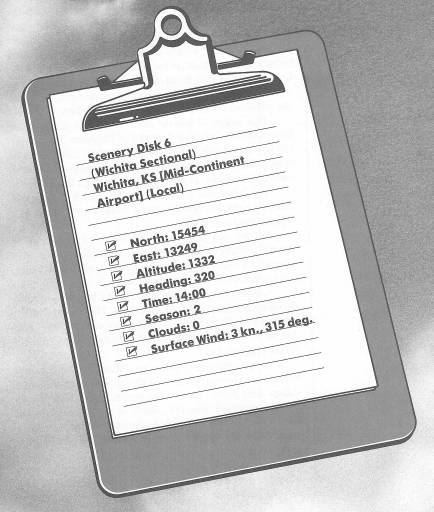Runway USA
A pilot's guide to destination cities in Flight Simulator
by Charles Gulick
In a Spin

Wichita Mid-Continent is a big airport, as you'll see if you take a look at it on radar. It lies in the southwest corner of the city of Wichita. In the southeast corner of the city is the equally big McConnell Air Force Base. Whatever plane you're flying, you'll be interested to know that just above McConnell Air Force Base is the landing field for the Cessna factory, although it isn't in the simulation. A little north of the Cessna field is Beech Aircraft's airport; and a few miles north of that is the airport for the Piper factory. So, many fine airplanes make their first flight from Wichita.
This largest of Kansas cities started its career when Jesse Chisholm made it part of the Chisholm Trail in the 1860s—a trail that ended about a hundred miles north of here, in Abilene, Kansas. We saw the beginnings of that trail earlier in this book, in the chapter “The Right Stuff.”
This afternoon you'll find out how much of the right stuff you have, because I'm going to show you how to do a popular stunt—the spin.
But for this you'll need, among other things, some altitude. So take off, and as you climb watch for a lake over to your left. It's north of the highway that leads into Wichita, and when you see the lake, head toward it.
Actually, it's not simply a lake, but Cheney Reservoir. Continue climbing as you approach it. The altitude you're heading for is 7000 feet. Climb at a rate of about 500 FPM. And be sure to take a look at Wichita and the Mid-Continent Airport behind you.
You probably won't have your altitude by the time you reach the reservoir, so fly a wide circle around the area, using a very shallow bank, while continuing to climb. You've probably watched from the ground as a small airplane did something like this—climbing, climbing until it was just a speck in the sky. It's almost a sure sign that the pilot is going to do some stunts.
And, like that pilot, you'll have to keep adding power or trimming your elevator up or both, to keep climbing as your altitude increases.
At 7000 feet, point into the wind and get into normal cruise configuration. Then go into the Editor, change the auto-coordination parameter to 0 (don't forget to press Return to establish this new parameter, because simply typing it doesn't do it), save the flight exactly as it is (be sure to do this), and exit again to the flight.
Now you'll be able to practice spins to your heart's content. You have the necessary altitude, the reservoir below as a reference point, and the flight conditions (including rudder control independent of aileron) saved, so all you need do is press Recall to try again.
Here's how to do a spin:
- First, be sure you know which keys control left and right rudders!
- Reduce your power setting to 0.
- Use up elevator to raise the nose of the aircraft until the horizon disappears, or until you get that jarring stall warning.
- When you get the warning, apply full rudder (left or right, depending in which direction you want to spin).
When you see the ground and Cheney Reservoir spinning—they're not. You are. And don't let the continued stall warning rattle you.
After a couple of revolutions, here's how to recover:
- Apply full opposite rudder (rudder opposite to the direction of spin).
- Apply down elevator to reduce your present angle of attack.
- When the plane stops spinning, use aileron (the artificial horizon will help you here) to get your wings level and restore the real horizon.
- Then add back your power, and use throttle plus elevator and aileron, to get straight and level again.
It may surprise you to see that you lose relatively little altitude (how much depends on how many revolutions you make) in a spin. The reason is that the airplane is not diving, but more or less wallowing downward. You'll lose altitude, of course, but probably not as much as you expected when you saw that ground and water spinning up at you.
The Recall key will put you back at 7000 feet, ready to go again, saving you that long climb up—which is one advantage simulation has over the real thing. Can you think of another?
When you have done all the spinning you have the stomach for, enter the Editor again and change your auto-coordination back to 1 (unless you feel like experimenting with non-coordinated flight for a while).
Now head back to Wichita Mid-Continent Airport and your landing on Runway 32.
Table of Contents | Previous Chapter | Next Chapter
